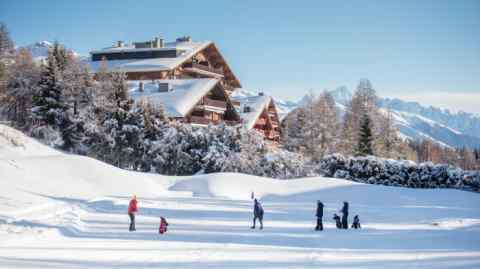 . . . inside one of the apartments at R├йsidence de la Couronne, Grimentz ┬й Alpine Property Finders
. . . inside one of the apartments at R├йsidence de la Couronne, Grimentz ┬й Alpine Property Finders
Switzerland has entered the market, with projects in Grimentz priced from SFr659,000 ($750,000) through Alpine Property Finders. The latest Swiss condo-hotel project, announced here for the first time, is in the resort of Andermatt. The Alpinist will be a five-star, 66-room hotel with 164 residences, with studios starting from SFr595,000. The waiting list for off-plan purchases opens next month. тАЬAndermatt already has two condo-hotels,тАЭ says Russell Collins, chief commercial officer at Andermatt Swiss Alps, but тАЬThe Alpinist follows the US model more closely,тАЭ he says, promising an approach тАЬbased around a strong community and shared passion for the Alps.тАЭ Designed by Norwegian practice Snohetta, The Alpinist will have AndermattтАЩs largest spa and a three-storey gym.
Subscription services тАФ whereby skiers pay a fee for unlimited access to a companyтАЩs resorts around the world тАФ is another US-inspired concept that aims to build a community, and is encouraging Americans to ski in Europe in increasing numbers. Vail Resorts owns and manages 37 North American resorts, including the giants of Vail and Whistler Blackcomb, and three in Australia. In 2022 it bought a controlling interest in Andermatt-Sedrun and this year added Crans-Montana to its books. Its annual Epic Pass allows unlimited ski access to all Vail-owned resorts, and also to partner resorts including Verbier, FranceтАЩs Three Valleys and Ski Arlberg in Austria.
 In Le Praz village, a gondola takes skiers to Courchevel 1850 in six minutes ┬й Courchevel Tourisme
In Le Praz village, a gondola takes skiers to Courchevel 1850 in six minutes ┬й Courchevel Tourisme
Vail Resorts plans to invest around SFr30mn in Crans-Montana in the next five years, expanding snow-making capabilities and improving restaurants. Its aim is to тАЬallow the resort to make more snow with less energy and water and support an earlier opening each season,тАЭ says Laura Bonfiglio from Vail Resorts. Over the past 10 years, the company has invested more than $2bn in its mountain resorts, she says.
This planned investment in Crans-Montana is already having an impact on international arrivals says local resident Cassandra Levene, managing director at Alpine Homes International. тАЬCrans needed something new. This winter will be the first season under Vail Resorts and the impetus it has given already is exciting, with new fashion brands and restaurants like La Ferme Saint-Amour opening and the arrival of Six Senses,тАЭ says Levene, who has clients from Singapore and the US making a permanent move to the resort.
Vail ResortsтАЩ investment in Crans has not been without its critics, notes McKee, with charges of тАЬMcSkiтАЭ thrown about, but for both the resort and local homeowners, he sees it as a much needed shot in the arm. тАЬItтАЩs a prime opportunity to bring Crans, which had an ageing demographic, to a new audience,тАЭ he says. Prices in Crans-Montana are at least 40 per cent lower than Verbier, its peer in Valais, according to UBS 2023 figures.
 Vail Resorts plans to invest heavily in Crans-Montana тАФ it offers a US-style subscription model via its annual Epic Pass ┬й Anthony Vuignier
Vail Resorts plans to invest heavily in Crans-Montana тАФ it offers a US-style subscription model via its annual Epic Pass ┬й Anthony Vuignier
High costs are one characteristic of North American resorts that skiers might prefer were not imported. This season, skiers will pay up to US$179 for a day lift pass in Aspen compared with тВм79 in FranceтАЩs Three Valleys, but Giles Gale argues that this extra revenue is used for improvements to infrastructure.
тАЬIn smaller European resorts it can be hard to get new investment because of the historic way the resorts developed,тАЭ he says. тАЬApart from the purpose-built French resorts, many resorts are on land originally owned by farming families, in villages that have evolved over centuries. In North America, resorts grew less organically, mostly master planned. That provides huge convenience for skiers but often without the charm of the Alps, one reason why many Americans come to ski in Europe. ItтАЩs as much a cultural experience as a sporting one.тАЭ
EuropeтАЩs piecemeal evolution also means that ownership of ski lifts, hotels and local businesses is often fragmented. In North America, the owners and operators of the lift system often have a stake in hotels and accommodation, giving them an incentive to keep the slopes open for as long a season as possible. Vail ResortsтАЩ investment in Crans-Montana includes majority ownership of the ski infrastructure as well as a ski school, real estate company and 11 restaurants.
тАЬFor home buyers, thereтАЩs often more surety and confidence in a destination where thereтАЩs a common interest in operating the resort smoothly for everyone,тАЭ says Collins.
Recommended

For Gale, a life-long skier with a family property in the Austrian Alps, where would he choose to ski? тАЬIf you can afford it, the skiing in North America is exceptional, slick and professionally done,тАЭ he says. тАЬIf forced to choose, I would head to North America for a week of hardcore, thrash-the-slopes skiing, but if I wanted a fun skiing holiday, mixing time on and off the piste with friends and family, IтАЩd definitely go to Europe.тАЭ
Find out about our latest stories first тАФ follow @ft_houseandhome on Instagram
Source link : http://www.bing.com/news/apiclick.aspx?ref=FexRss&aid=&tid=6735b4b4d01c4881887ada1d23197885&url=https%3A%2F%2Fwww.ft.com%2Fcontent%2Fe57709e6-3f18-4d0e-9cc3-8be475d526e4&c=3336434836826159372&mkt=en-us
Author :
Publish date : 2024-11-13 11:00:00
Copyright for syndicated content belongs to the linked Source.












